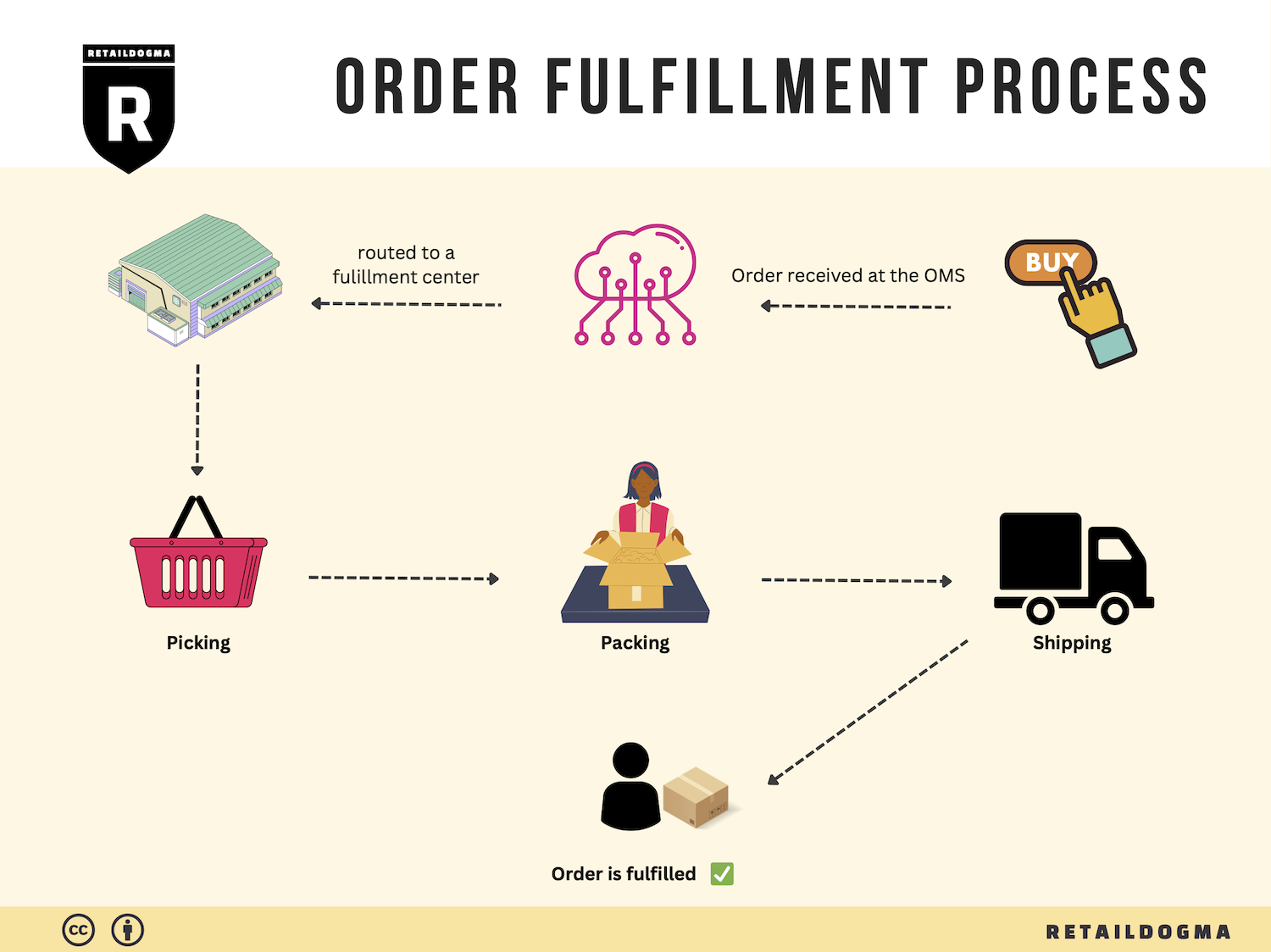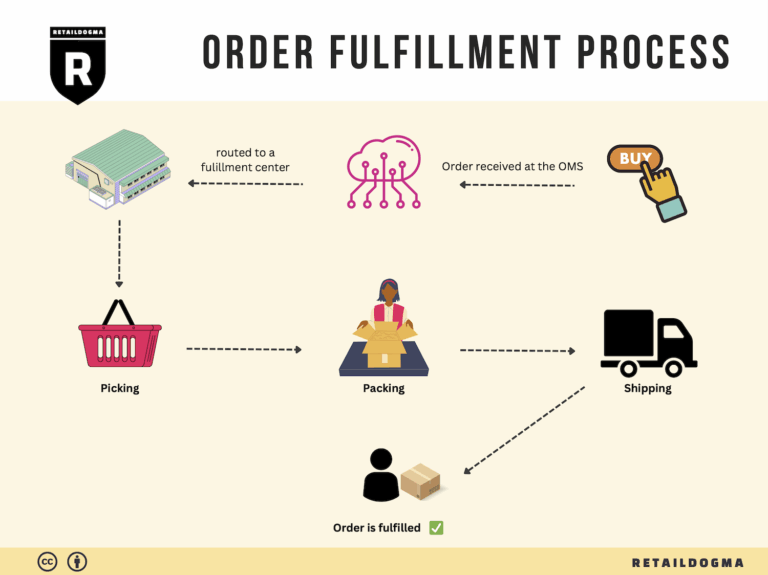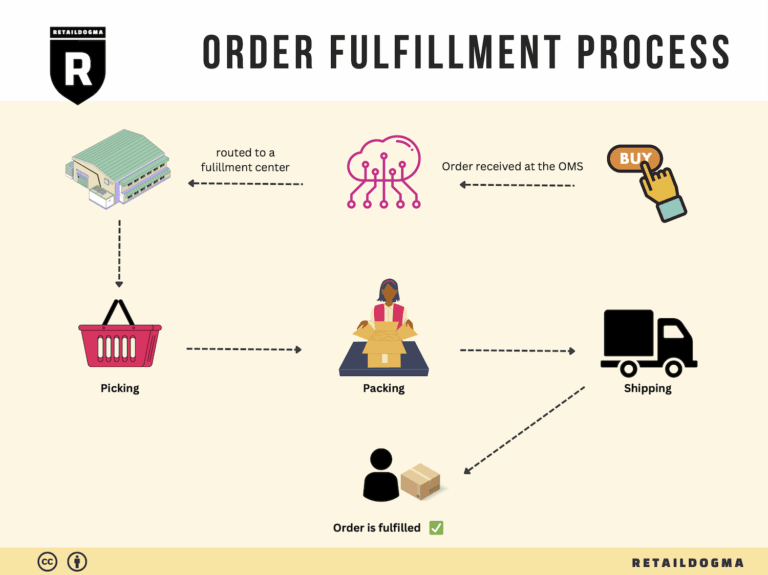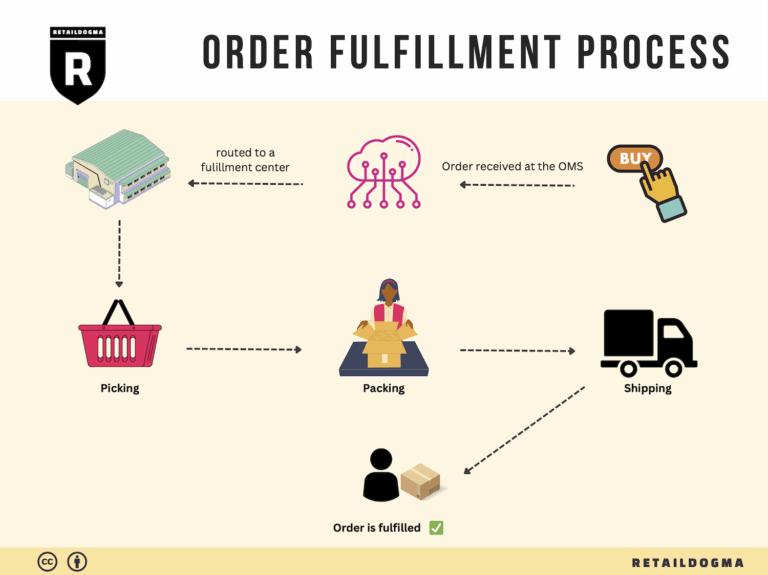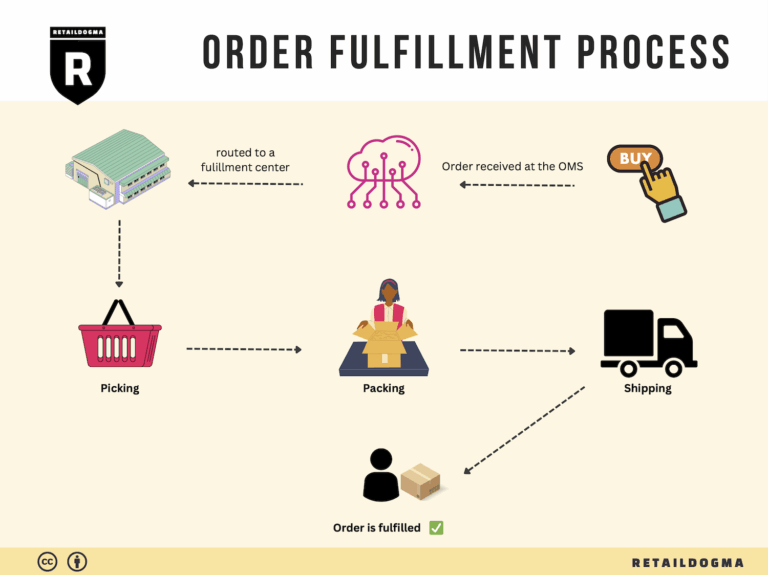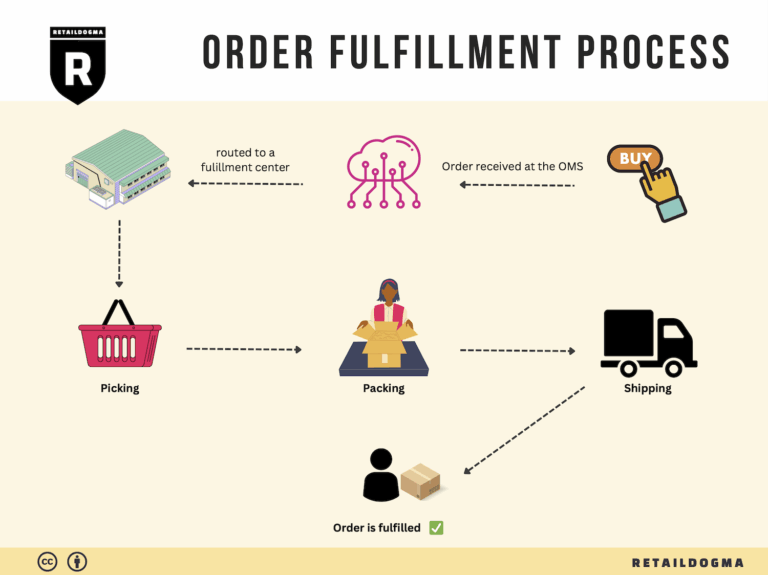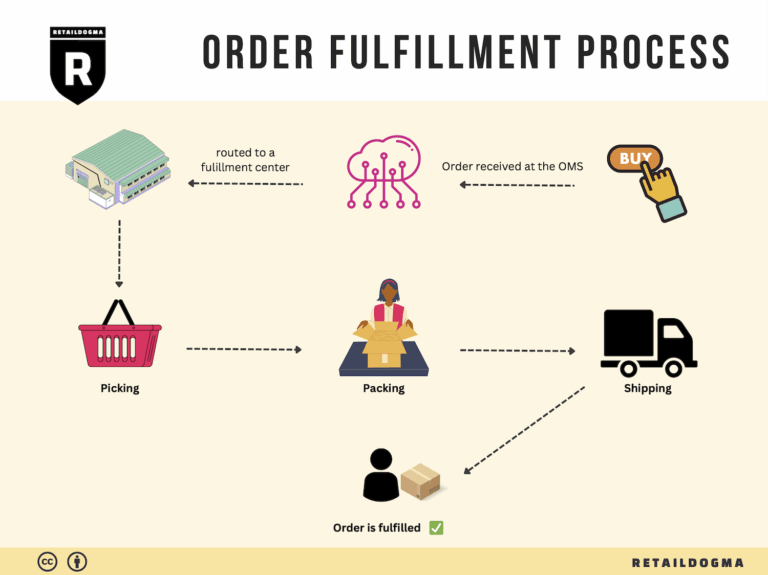Ecommerce Fulfillment Services: The Ultimate Guide (2025)
What is E-commerce Fulfillment? An Introduction for Growing Businesses
Understanding the E-commerce Fulfillment Process
As an e-commerce business owner, you may find yourself grappling with the overwhelming tasks of packing and shipping orders. These logistical challenges can divert your focus from what truly matters—growing your business. E-commerce fulfillment is the backbone of your operations, encompassing the entire process of getting a product from your warehouse to the hands of your customers. Understanding this crucial aspect of your business is essential for scaling effectively.
Fulfillment can be defined simply as the series of steps taken to prepare and deliver a product to a customer after they place an order. This involves receiving inventory, processing orders, picking and packing items, and arranging for shipping. As your business grows, the complexity of these tasks can increase, leading to delays, errors, and customer dissatisfaction. This guide aims to simplify the fulfillment process and help you navigate the various options available to streamline your logistics.
In this comprehensive resource, we will explore different fulfillment models, including Third-Party Logistics (3PL) and Fulfillment by Amazon (FBA). Each model has its strengths and weaknesses, depending on your business needs and scale. We will also delve into core fulfillment services such as inventory management, order processing, packaging, and shipping.
Choosing the right fulfillment partner is pivotal to your success. We’ll provide insights on what to look for in a fulfillment center, including their technology capabilities, service offerings, and customer support. Understanding pricing structures is equally important; we will break down the costs associated with different fulfillment models to help you make informed financial decisions.
Ultimately, this guide’s goal is to empower you to make strategic choices about your logistics. By understanding the ins and outs of e-commerce fulfillment, you can optimize your operations, improve customer satisfaction, and position your business for sustainable growth. Whether you are just starting or looking to scale, having a solid grasp of fulfillment will enable you to focus on what you do best—delivering exceptional products and experiences to your customers.
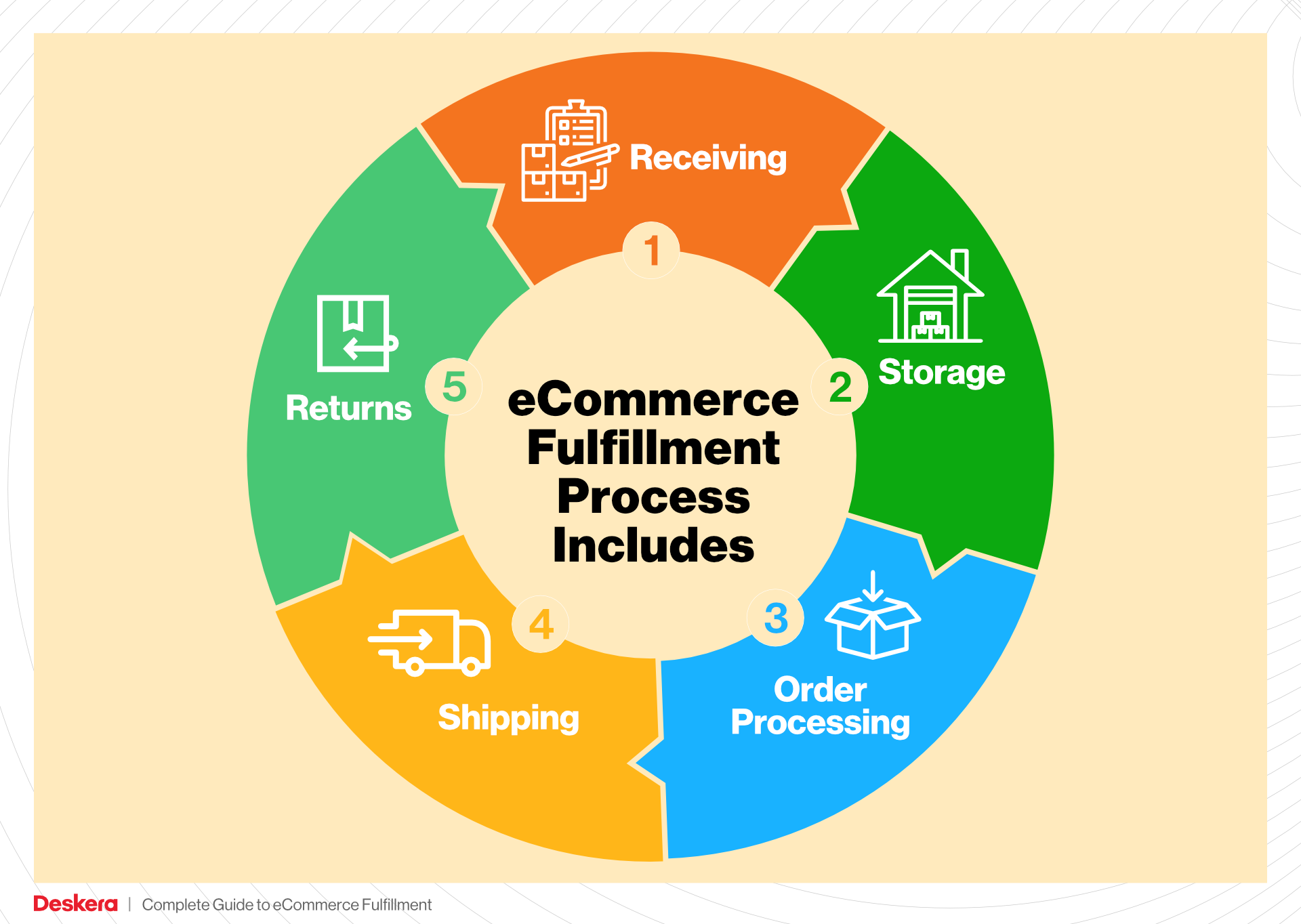
What You’ll Learn In This Guide
- What is E-commerce Fulfillment? An Introduction for Growing Businesses
- The Order Fulfillment Process: From ‘Buy’ Button to Customer’s Door
- Comparing Fulfillment Models: In-House vs. 3PL vs. Dropshipping
- A Deep Dive into Amazon FBA: Pros, Cons, and Who It’s For
- Core Services Offered by Fulfillment Centers
- How to Choose a Fulfillment Partner: A 6-Point Checklist
- Understanding Fulfillment Pricing: A Breakdown of Common Fees
- Frequently Asked Questions (FAQs) about Fulfillment
- Conclusion: Is Outsourcing Fulfillment the Right Move for Your Business?
- Important Disclaimer
The Order Fulfillment Process: From ‘Buy’ Button to Customer’s Door
1. Receiving Inventory
The order fulfillment process begins with receiving inventory at your fulfillment center. Upon arrival, the goods are unloaded, and the first critical step is to conduct a thorough inspection. This includes verifying the quantities against shipping documents and checking for any damages. Key terms associated with this step include SKU (Stock Keeping Unit), which helps in identifying individual products.
This stage is crucial because accurate receiving ensures that inventory records are correct, which is essential for maintaining stock levels and preventing stockouts or overstock situations. A well-managed receiving process lays the groundwork for the entire fulfillment operation, ensuring that products are accounted for and ready for storage.
2. Warehouse Storage
Once the inventory has been received and verified, the next step is warehouse storage. Products are strategically placed in designated locations within the warehouse, optimizing space and accessibility. The use of WMS (Warehouse Management System) software can significantly enhance this process by tracking inventory levels and locations in real time.
Efficient warehouse storage is vital for minimizing retrieval times during order picking. Proper organization, such as categorizing items by SKU or demand frequency, can streamline operations and reduce errors. This step not only maximizes the utilization of available space but also facilitates a smoother transition to the next phase of the fulfillment process.
3. Order Picking
When a customer places an order, the next step is order picking, where items are retrieved from their storage locations. This is typically done using pick lists, which detail the items and their corresponding locations within the warehouse. Picking can be performed manually or with the aid of automated systems, depending on the scale and complexity of the operation.
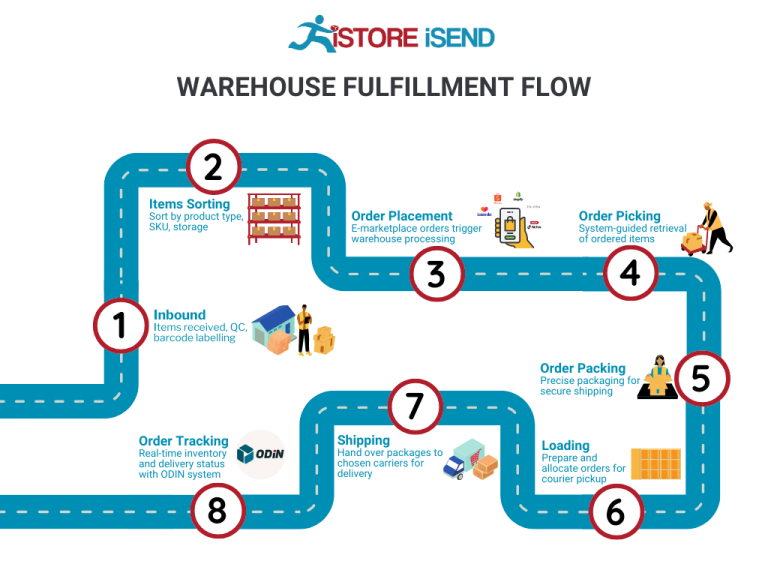
Effective order picking is crucial for maintaining customer satisfaction. The speed and accuracy with which orders are fulfilled can significantly impact a business’s reputation and repeat customer rates. Utilizing advanced picking strategies, such as batch picking or zone picking, can help increase efficiency and reduce labor costs, ensuring that orders are processed quickly and accurately.
4. Order Packing
Once items have been picked, they move to the packing stage. Here, products are carefully packed to ensure they arrive at the customer’s doorstep in perfect condition. This process often involves using packing slips, which accompany the order and detail the contents for the customer, as well as any necessary return instructions.
Packing is a critical step as it directly influences customer experience. High-quality packing materials and methods can prevent damage during shipping, while also providing an opportunity for branding through custom packaging. A well-executed packing process ensures that orders are not only secure but also presentable, enhancing the customer’s unboxing experience.
5. Shipping & Delivery
The final step in the order fulfillment process is shipping and delivery. Once orders are packed, they are labeled and prepared for shipment. This involves selecting the most efficient shipping method and carrier, often facilitated by TMS (Transportation Management System) software, which helps optimize routes and manage carrier relationships.
Shipping is a pivotal aspect of fulfillment, as it directly affects delivery speed and costs. Utilizing multiple carrier options allows businesses to provide various delivery speeds, including expedited shipping, which can be a significant competitive advantage. Furthermore, real-time tracking capabilities enhance customer satisfaction by keeping them informed about their order status, from dispatch to delivery.
In summary, understanding and optimizing each step of the order fulfillment process—from receiving inventory to shipping and delivery—can significantly enhance operational efficiency and customer satisfaction. By implementing best practices and leveraging technology, e-commerce businesses can scale effectively and meet growing customer demands.
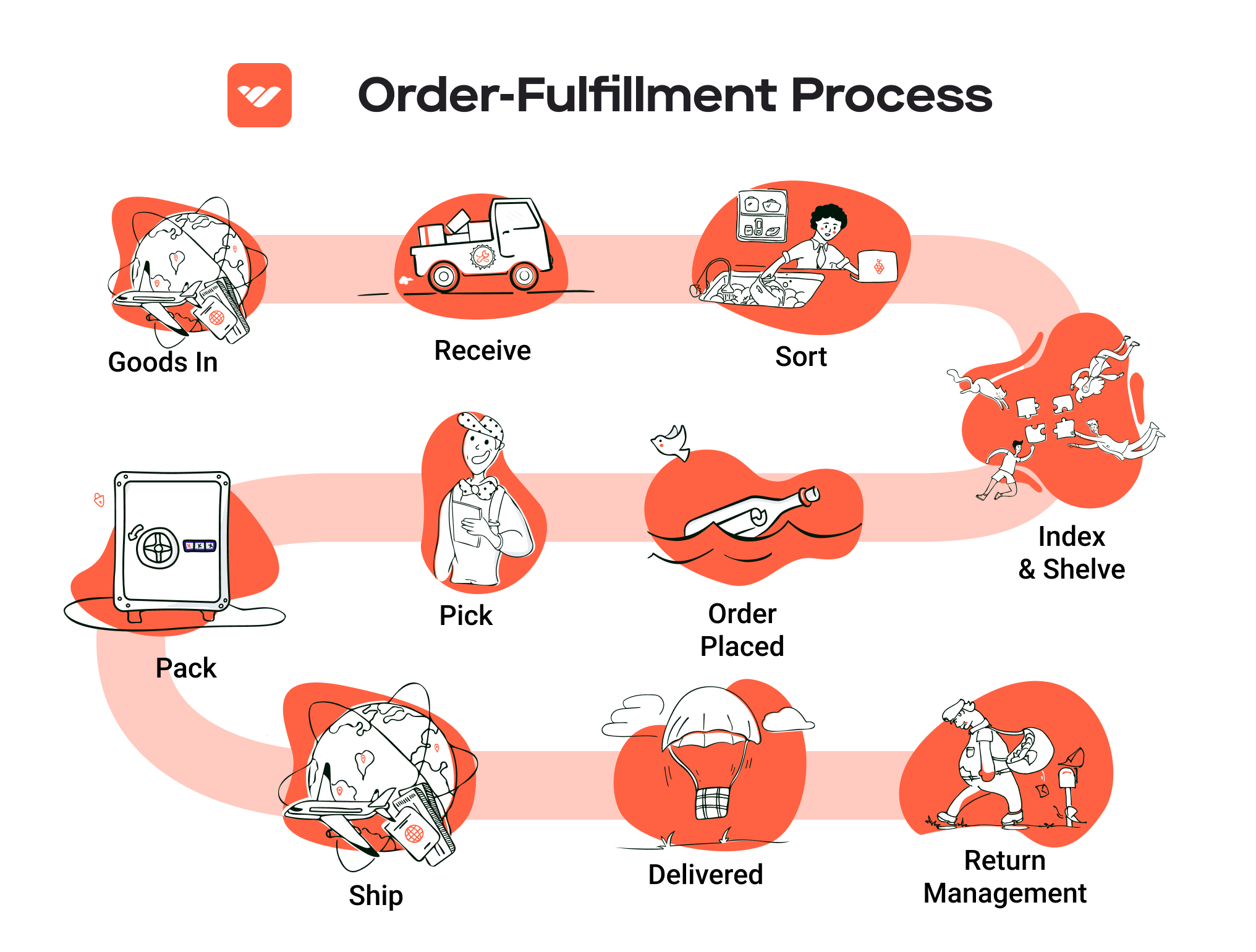
Comparing Fulfillment Models: In-House vs. 3PL vs. Dropshipping
Fulfillment Model Comparison
| Model | Who Handles Inventory | Best For (Business Stage) | Key Advantage | Key Disadvantage |
|---|---|---|---|---|
| In-House Fulfillment | The business itself | Startups and established businesses with steady demand | Full control over inventory and processes | High overhead costs and labor management |
| Third-Party Logistics (3PL) | 3PL provider | Growing businesses looking to scale | Access to expertise, technology, and scalability | Less control over logistics and fulfillment |
| Dropshipping | Supplier | New entrants or low-risk businesses | Minimal upfront investment and risk | Lower profit margins and reliance on suppliers |
In-House Fulfillment
In-house fulfillment means that a business manages its own warehousing, inventory management, and order processing. This model is most suitable for startups and established businesses that have a steady demand for their products. One of the primary advantages of in-house fulfillment is the control it offers; businesses can oversee every aspect of their logistics, from inventory management to shipping processes. This allows for tailored packaging, personal customer service, and the ability to implement specific operational strategies. However, the key disadvantage is the high overhead costs associated with staffing, warehousing, and maintaining the necessary technology. As the business grows, managing these logistics can become complex and resource-intensive, potentially detracting from core business activities.
Third-Party Logistics (3PL)
Third-party logistics (3PL) providers offer comprehensive logistics services, including warehousing, inventory management, order fulfillment, and shipping. This model is ideal for growing businesses looking to scale their operations without the burden of managing logistics internally. Utilizing a 3PL allows businesses to leverage the provider’s expertise, advanced technology, and established carrier relationships, which can lead to significant cost savings and efficiency gains. For example, a fulfillment center in Florida, like MyFBAPrep, can provide tailored services including inventory optimization and direct-to-consumer delivery, enabling businesses to meet customer expectations quickly. However, the downside is that businesses relinquish some control over their logistics processes. This can lead to challenges in maintaining quality standards and consistency, particularly if the 3PL does not align perfectly with the company’s operational standards.
Dropshipping
Dropshipping is a fulfillment model where the business does not keep the products it sells in stock. Instead, when a customer orders a product, the business purchases the item from a third-party supplier who then ships it directly to the customer. This model is particularly attractive to new entrants or businesses seeking to minimize risk and upfront investment. Since there is no need to invest in inventory upfront, businesses can offer a wide range of products without the associated costs of warehousing and handling. However, the key disadvantage is the lower profit margins typically associated with dropshipping. Additionally, businesses are reliant on suppliers for inventory management and shipping, which can result in inconsistencies in product quality and delivery times. This reliance can negatively impact customer satisfaction and brand reputation if not managed carefully.
Conclusion
Choosing the right fulfillment model is crucial for e-commerce businesses aiming to scale effectively. Each model—In-House, 3PL, and Dropshipping—has its unique advantages and challenges, making it essential for business owners to assess their specific needs, resources, and growth aspirations. By understanding these differences, e-commerce operators can make informed decisions that align with their operational goals and customer expectations. Whether opting for the control of in-house fulfillment, the scalability of a 3PL, or the low-risk approach of dropshipping, the right choice will ultimately contribute to the success of the business in the competitive e-commerce landscape.
A Deep Dive into Amazon FBA: Pros, Cons, and Who It’s For
Understanding Fulfillment by Amazon (FBA)
Fulfillment by Amazon (FBA) is a service provided by Amazon that allows e-commerce sellers to store their products in Amazon’s fulfillment centers. In this model, Amazon takes care of storage, packaging, shipping, and customer service for these products. Sellers can leverage Amazon’s vast logistics network to reach customers efficiently while focusing on other aspects of their business.
When a customer places an order for an FBA product, Amazon handles the entire fulfillment process, including picking, packing, and shipping the product directly to the customer. This service not only streamlines the order fulfillment process but also offers sellers the ability to scale their operations without investing heavily in their logistics infrastructure.
How FBA Works
-
Product Listing: Sellers create product listings on Amazon and indicate that they wish to use FBA.
-
Shipping Inventory: Sellers send their products to Amazon’s fulfillment centers. This can be done in bulk, and Amazon provides guidelines on how to label and package products to meet their standards.
-
Storage: Once the inventory arrives at the fulfillment center, Amazon stores it until orders are placed.
-
Order Fulfillment: When a customer orders a product, Amazon picks, packs, and ships the item on behalf of the seller. They also handle customer service and returns.
-
Payment: Sellers receive payment after the sale, minus the fees charged by Amazon for using FBA.
-
Multi-Channel Fulfillment: Sellers can also use FBA to fulfill orders from their own websites or other platforms, giving them flexibility in managing their sales channels.
Pros of Using FBA
1. Prime Eligibility
One of the most significant advantages of FBA is that products fulfilled by Amazon are eligible for Amazon Prime. This means that Prime members can enjoy free two-day shipping on these items, increasing the likelihood of sales. As Prime membership continues to grow, having Prime-eligible products can significantly boost visibility and conversion rates.
2. Customer Trust
When customers see the “Fulfilled by Amazon” logo, it instills a sense of trust and reliability. Amazon is known for its excellent customer service and fast shipping, which can enhance customer satisfaction and loyalty. This trust can lead to higher sales and repeat purchases.
3. Multi-Channel Fulfillment
FBA allows sellers to fulfill orders from multiple sales channels, not just Amazon. Whether you sell on eBay, Shopify, or your own website, you can use Amazon’s logistics network to manage your inventory and fulfill orders. This flexibility can simplify logistics and save time.
4. Time Savings
With Amazon handling storage, packing, and shipping, sellers can focus on other critical aspects of their business, such as marketing, product development, and customer engagement. This can lead to better business growth and scalability.
5. Advanced Logistics
Amazon’s robust logistics network provides sellers with access to advanced shipping options, including international shipping, which can help expand their market reach. Additionally, their extensive fulfillment centers enable faster shipping times across the country.
Cons of Using FBA
1. High Fees
While FBA offers significant advantages, it comes with various fees, including storage fees, fulfillment fees, and additional costs for long-term storage. These fees can add up, particularly for sellers with lower-priced items or slow-moving inventory, potentially squeezing profit margins.
2. Strict Inventory Rules
Amazon has strict guidelines regarding inventory management. Sellers must adhere to specific packaging and labeling requirements, which can be time-consuming and may require additional resources. Non-compliance can lead to delays or additional fees.
3. Commingling Risks
FBA operates on a commingling model, where inventory from different sellers may be mixed in the same fulfillment center. This can lead to potential issues if a seller’s products are damaged or if counterfeit goods are shipped under their listing, affecting their reputation and sales.
4. Limited Control
Using FBA means relinquishing some control over the fulfillment process. Sellers depend on Amazon for shipping speed and customer service, which can lead to inconsistencies in customer experience. Sellers may find it challenging to manage issues that arise during the fulfillment process.
5. Inventory Management Challenges
While FBA provides inventory management tools, tracking inventory levels across multiple platforms can be complex. Sellers must be diligent in managing stock levels to avoid stockouts or excess inventory, which can incur additional fees.
Who is FBA Best For?
FBA is particularly beneficial for:
-
Small to Medium-Sized Businesses: Businesses looking to scale without investing heavily in logistics can find FBA a cost-effective solution.
-
E-commerce Entrepreneurs: New sellers who want to leverage Amazon’s massive customer base and logistics capabilities can benefit from the instant credibility and reach that FBA provides.
-
Sellers with High Volume: Businesses that sell a large volume of products can capitalize on the efficiency of Amazon’s fulfillment services, reducing overhead costs and optimizing order processing.
-
Multi-Channel Sellers: Sellers who operate across various platforms can streamline their logistics by using FBA for all order fulfillment, simplifying their operations.
-
Brands Focused on Customer Experience: Companies that prioritize customer satisfaction and want to leverage Amazon’s reputation for excellent service can enhance their brand image through FBA.
In conclusion, while Fulfillment by Amazon offers numerous advantages that can help businesses grow and thrive in the competitive e-commerce landscape, it is essential for sellers to weigh these benefits against the potential drawbacks. Understanding the intricacies of FBA will empower e-commerce business owners to make informed decisions that align with their growth strategies.
Core Services Offered by Fulfillment Centers
Inventory Management & Warehousing
Inventory management and warehousing are critical components of the fulfillment process that directly impact an e-commerce business’s efficiency and profitability. Fulfillment centers offer dedicated spaces where businesses can store their products in an organized manner. This service typically includes advanced inventory tracking systems that provide real-time visibility into stock levels, locations, and conditions of the products.
Benefits:
– Enhanced Efficiency: By utilizing a fulfillment center’s inventory management system, e-commerce businesses can minimize the risks of stockouts or overstocking. This optimizes cash flow and ensures that products are available when customers demand them.
– Scalability: As your business grows, fulfillment centers can easily scale their warehousing solutions to accommodate increased inventory without the need for significant upfront investment in physical space.
– Reduced Overhead Costs: Outsourcing warehousing to a fulfillment center eliminates the need for businesses to maintain their own storage facilities, which can be costly. This allows companies to focus on core business activities rather than logistics.
Pick and Pack Services
Pick and pack services are a fundamental offering of fulfillment centers that involve the selection of ordered items from inventory (picking) and packaging them for shipment (packing). This process is typically automated and optimized using sophisticated software systems that ensure accuracy and speed.
Benefits:
– Speed of Fulfillment: With streamlined pick and pack processes, fulfillment centers can significantly reduce the time it takes to fulfill orders. This is crucial for meeting customer expectations, particularly in an era where same-day or next-day delivery is becoming the norm.
– Accuracy and Quality Control: Fulfillment centers implement quality control measures during the pick and pack process, such as double-checking items against orders. This reduces the likelihood of errors that can lead to customer dissatisfaction and returns.
– Flexibility: Businesses can tailor their pick and pack services to accommodate various packaging requirements, whether it’s for single items, bulk orders, or special gift packaging, enhancing the customer experience.
Kitting and Assembly
Kitting and assembly are specialized services offered by fulfillment centers that involve combining multiple products into a single ready-to-sell unit. This can include bundling items, creating promotional kits, or assembling products that require multiple components.
Benefits:
– Increased Sales Opportunities: Kitting allows businesses to create unique product offerings, such as gift sets or subscription boxes, which can enhance customer appeal and drive additional sales.
– Streamlined Operations: By outsourcing kitting and assembly to a fulfillment center, businesses can save time and resources. This allows them to focus on their core competencies, such as marketing and product development, rather than the logistical complexities of assembly.
– Improved Customer Experience: Well-packaged kits not only look professional but also enhance the unboxing experience for customers, which can lead to positive reviews and repeat business.
Returns Management (Reverse Logistics)
Returns management, also known as reverse logistics, is a vital service provided by fulfillment centers that deals with the process of handling returned products. This includes receiving returns, inspecting items, processing refunds or exchanges, and managing the restocking of inventory.
Benefits:
– Enhanced Customer Satisfaction: A streamlined returns process can significantly improve the overall customer experience. By offering efficient returns management, businesses can build trust and loyalty with their customers, leading to repeat purchases.
– Cost Reduction: Fulfillment centers often have established processes for handling returns, which can reduce the costs associated with managing returns in-house. This includes labor costs, shipping fees, and potential losses from unsellable items.
– Data Insights: Analyzing return data can provide valuable insights into product performance and customer preferences. This information can guide inventory management, product development, and marketing strategies to minimize future returns.
By leveraging these core services, e-commerce businesses can optimize their logistics operations, enhance customer satisfaction, and ultimately scale their operations more effectively. Partnering with a fulfillment center not only streamlines processes but also allows businesses to focus on growth and innovation in a competitive marketplace.
How to Choose a Fulfillment Partner: A 6-Point Checklist
Location & Warehouse Network
Importance:
The geographic location of a fulfillment partner is crucial for ensuring timely delivery and optimizing shipping costs. A strategically located warehouse network can significantly enhance your logistics capabilities, especially for e-commerce businesses aiming for rapid delivery.
Questions to Ask:
– Where are your warehouses located, and how many do you operate?
– What is the average delivery time to key markets from your warehouses?
– Can you provide options for distributing inventory across multiple locations to minimize shipping times?
Technology & Integrations
Importance:
In today’s fast-paced e-commerce environment, technology plays a vital role in streamlining operations. A partner that utilizes advanced Warehouse Management Systems (WMS), Inventory Management Systems (IMS), and Transportation Management Systems (TMS) can provide real-time visibility into your inventory and streamline the fulfillment process.
Questions to Ask:
– What technology platforms do you use for inventory and order management?
– Can your systems integrate with our existing e-commerce platforms (e.g., Shopify, Amazon, WooCommerce)?
– How do you ensure data security and accuracy in your systems?
Specializations (e.g., cold storage, oversized items)
Importance:
Different businesses have unique requirements depending on their products. If you sell perishable goods, electronics, or oversized items, you need a partner with the capability to handle your specific needs efficiently.
Questions to Ask:
– Do you have specialized facilities for temperature-sensitive items or oversized products?
– What specific services do you offer for unique product handling (e.g., kitting, bundling)?
– Can you accommodate seasonal fluctuations in inventory volume or product types?
Scalability & Capacity
Importance:
As your business grows, your fulfillment needs will likely change. It’s essential to partner with a fulfillment center that can scale alongside your business without compromising service quality or speed.
Questions to Ask:
– What is your current capacity, and how quickly can you scale up to meet increased demand?
– Do you have a plan for managing peak seasons or unexpected surges in order volume?
– How do you handle slow-moving inventory or returns?
Pricing and Contracts
Importance:
Understanding the cost structure and contractual obligations is crucial to maintaining profitability. Transparent pricing models help you assess the total cost of ownership and avoid unexpected fees.
Questions to Ask:
– Can you provide a breakdown of your pricing structure, including pick and pack fees, storage fees, and shipping costs?
– Are there any additional costs we should be aware of (e.g., setup fees, minimum order requirements)?
– What are the terms of the contract, and is there flexibility for renegotiation as our needs change?
Customer Support & Reviews
Importance:
Reliable customer support is essential for resolving issues quickly and maintaining smooth operations. Additionally, customer reviews can provide insights into the partner’s reliability and service quality.
Questions to Ask:
– What kind of customer support do you offer (e.g., dedicated account manager, 24/7 support)?
– How do you handle issues related to order inaccuracies or fulfillment delays?
– Can you provide references or case studies from clients in our industry?
Conclusion
Choosing the right fulfillment partner is a critical decision that can significantly impact your e-commerce operations. By using this checklist, you can ensure that you cover all essential aspects of a potential partnership. Take the time to evaluate each point carefully, ask the right questions, and consider the long-term implications of your choice. A strategic fulfillment partner can be a valuable ally in your growth journey, helping you deliver exceptional service to your customers while optimizing your logistics operations.
Understanding Fulfillment Pricing: A Breakdown of Common Fees
Initial Setup Fees
Initial setup fees are typically charged when you first engage a fulfillment center’s services. These fees can cover various aspects, including account setup, software integration, and the onboarding process. The cost can vary widely based on the complexity of your operations and the systems you need to integrate.
For example, a fulfillment center might charge a flat fee for account creation and necessary software setup, which can range from a few hundred to several thousand dollars. If your business requires custom solutions or additional training for your staff, this could further increase the initial costs. It’s essential to clarify what services are included in the setup fee to avoid unexpected expenses.
Receiving Fees
Receiving fees are incurred when your inventory arrives at the fulfillment center. These fees cover the labor and processes involved in unloading, inspecting, and storing your products. The cost is generally based on the volume of items received and can be calculated per pallet or per item.
For instance, if a fulfillment center charges $25 per pallet, and your shipment contains 10 pallets, your receiving fee would be $250. If your products require additional quality assurance checks or special handling, expect these fees to increase. Always ask for a breakdown of what the receiving fees cover to ensure you understand the total cost.
Storage Fees (per pallet/bin)
Storage fees are charged for the space your inventory occupies within the fulfillment center. These fees can be calculated on a monthly basis and are often based on the number of pallets or bins your products occupy.
For example, if a fulfillment center charges $15 per pallet per month and you store 5 pallets, your monthly storage fee would be $75. Some fulfillment centers may also charge based on cubic footage or even offer tiered pricing structures based on the volume of inventory you maintain. Keep in mind that seasonal fluctuations in inventory levels can affect your storage costs, so plan accordingly.
Pick & Pack Fees (per item/order)
Pick and pack fees are incurred each time an order is fulfilled. This fee typically covers the labor involved in retrieving items from storage, packing them for shipment, and preparing them for delivery.
The calculation for pick and pack fees can vary; some centers charge a flat fee per order, while others charge per item picked. For instance, if a fulfillment center charges $2 per item and you have an order of 10 items, your pick and pack fee would be $20. Understanding how these fees are structured is crucial for accurately forecasting your fulfillment costs, especially if your product offerings change frequently.
Shipping Fees
Shipping fees are a significant component of fulfillment pricing and can vary based on several factors, including the destination, shipping method, and carrier used. Fulfillment centers often negotiate rates with carriers, which can lead to cost savings for your business.
Shipping fees can be calculated based on the weight and dimensions of the package, as well as the distance to the delivery address. For example, a fulfillment center might charge $5 for shipping within the same state but $15 for shipping to another state. Be sure to clarify whether these fees are included in your overall fulfillment costs or billed separately.
Tips for Getting an Accurate Quote
-
Detailed Inventory List: Provide a comprehensive list of your products, including dimensions and weights. This information is crucial for accurate shipping and storage fee estimates.
-
Volume Estimates: Share your expected order volume and frequency. This allows fulfillment centers to offer more tailored pricing and identify potential discounts for higher volumes.
-
Clarify Services: Ensure you understand what is included in each fee type. Ask for a detailed breakdown to avoid hidden charges.
-
Compare Multiple Centers: Don’t settle for the first quote. Compare prices and services from multiple fulfillment centers to find the best fit for your business.
-
Negotiate Terms: Many fulfillment centers are open to negotiation, especially if you can commit to higher volumes or longer contracts.
By understanding the common fulfillment pricing models and how they are calculated, you can make informed decisions that align with your business needs and budget.
Frequently Asked Questions (FAQs) about Fulfillment
1. What is an Amazon fulfillment center in Florida?
An Amazon fulfillment center in Florida is a large warehouse facility where Amazon processes and ships customer orders. These centers are equipped with advanced technology and logistics systems to ensure efficient storage, order picking, packing, and shipping, enabling quick delivery to customers in the region.
2. How does Amazon fulfillment in Florida work?
When a customer places an order on Amazon, the fulfillment center retrieves the item from inventory, packs it, and ships it directly to the customer. The process is streamlined through automation and a network of carriers, allowing for fast shipping options, including same-day and two-day delivery.
3. What are the benefits of using an Amazon fulfillment center in Florida?
Utilizing an Amazon fulfillment center offers several advantages, including faster shipping times, access to Amazon’s extensive logistics network, reduced shipping costs, and the ability to leverage Amazon’s reputation for reliable delivery. This can enhance customer satisfaction and increase sales for e-commerce businesses.
4. What is the difference between a warehouse and a fulfillment center?
A warehouse primarily serves as a storage space for goods, focusing on inventory management. In contrast, a fulfillment center is designed to efficiently process and ship orders directly to customers, incorporating services like picking, packing, and shipping. Fulfillment centers are integral to e-commerce operations, enabling quicker order fulfillment.
5. What is a 3PL (Third-Party Logistics)?
A Third-Party Logistics (3PL) provider is a company that offers outsourced logistics services, including warehousing, fulfillment, and shipping. Businesses partner with 3PLs to manage their supply chain operations more effectively, allowing them to focus on core business activities while leveraging the expertise and resources of the 3PL.
6. How much do fulfillment services cost?
The cost of fulfillment services varies based on several factors, including the volume of orders, storage needs, packaging requirements, and shipping destinations. Typically, fulfillment fees can include a per-order fee, storage fees, and additional charges for services like kitting or custom packaging. It’s essential to request quotes from multiple providers to compare pricing.
7. Can I use Amazon fulfillment services for my own products?
Yes, businesses can use Amazon fulfillment services for their own products by enrolling in Fulfillment by Amazon (FBA). This program allows sellers to store their products in Amazon’s fulfillment centers, enabling them to take advantage of Amazon’s logistics network and customer service capabilities.
8. How do I manage inventory at an Amazon fulfillment center?
Inventory management at an Amazon fulfillment center is facilitated through Amazon’s Seller Central platform, where sellers can track stock levels, manage listings, and receive real-time analytics. Sellers are responsible for ensuring that their inventory is stocked adequately to meet customer demand and can utilize tools provided by Amazon to forecast needs.
9. What types of products can be fulfilled through Amazon fulfillment centers in Florida?
Amazon fulfillment centers can handle a wide range of products, including consumer electronics, clothing, household items, and more. However, certain items, such as hazardous materials or perishables, may have specific restrictions. Sellers should review Amazon’s guidelines to ensure compliance with their fulfillment policies.
10. How can I optimize my fulfillment process using Amazon centers in Florida?
To optimize your fulfillment process, consider strategies such as maintaining adequate inventory levels, using Amazon’s multi-channel fulfillment services, and leveraging Amazon’s analytics tools to monitor performance. Additionally, utilizing Amazon’s FBA program can streamline shipping and customer service, allowing you to focus on growing your business.
Conclusion: Is Outsourcing Fulfillment the Right Move for Your Business?
Evaluating the Benefits of Outsourcing Fulfillment
Outsourcing fulfillment can be a transformative move for e-commerce businesses aiming for growth and efficiency. One of the most significant advantages is time savings. By partnering with a dedicated fulfillment service, you free up valuable resources that can be redirected toward strategic initiatives such as marketing and product development. A professional fulfillment center can handle all aspects of logistics—from inventory management to last-mile delivery—allowing you to focus on scaling your business.
Scalability is another key benefit. As your business grows, your fulfillment needs will evolve. A competent fulfillment partner can adapt to these changing requirements, providing the infrastructure and support necessary to meet increased demand without the headaches of managing logistics in-house. Whether you experience seasonal spikes or sustained growth, a flexible fulfillment partner can help you navigate these challenges seamlessly.
Additionally, choosing the right fulfillment service brings expertise to your operations. Experienced partners come equipped with the latest technology and best practices, ensuring that your logistics processes are optimized for efficiency and accuracy. They can also offer insights into inventory trends and consumer behavior, helping you make informed decisions that drive sales.
Ultimately, the decision to outsource fulfillment should be based on a thorough evaluation of your current logistics operations. Take the time to audit your shipping processes and identify areas for improvement. Ask yourself if your current setup is meeting your business goals, or if partnering with a fulfillment center could enhance your operational capabilities.
Call to Action
If you find that your existing fulfillment strategy is limiting your growth potential, consider reaching out to a fulfillment expert today. The right partner can provide tailored solutions that align with your business objectives, positioning you for success in an increasingly competitive e-commerce landscape.
Important Disclaimer
⚠️ Important Disclaimer
The information in this guide is for educational purposes. Fulfillment services, pricing, and platform features change frequently. Always conduct your own due diligence and consult with providers directly before making business decisions.
